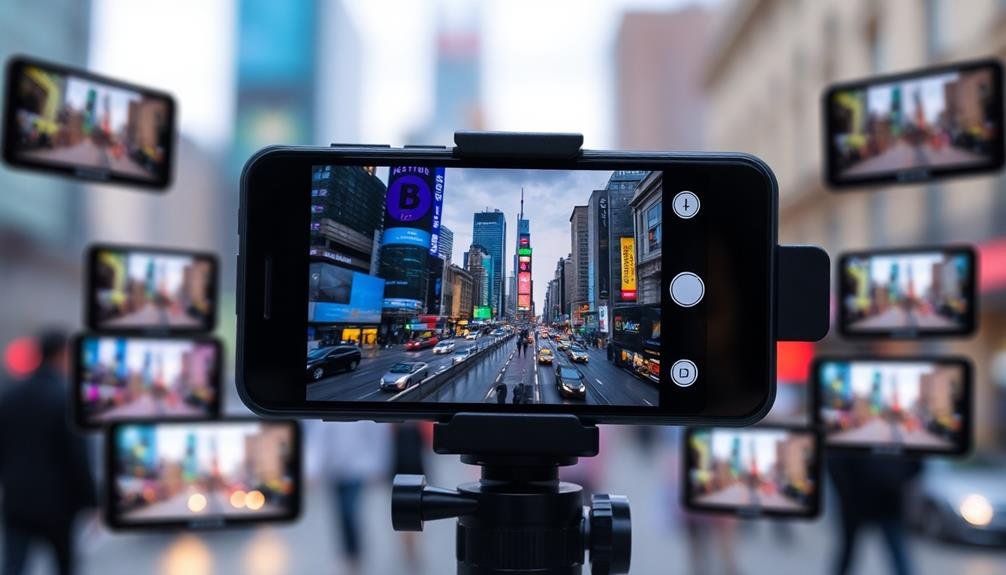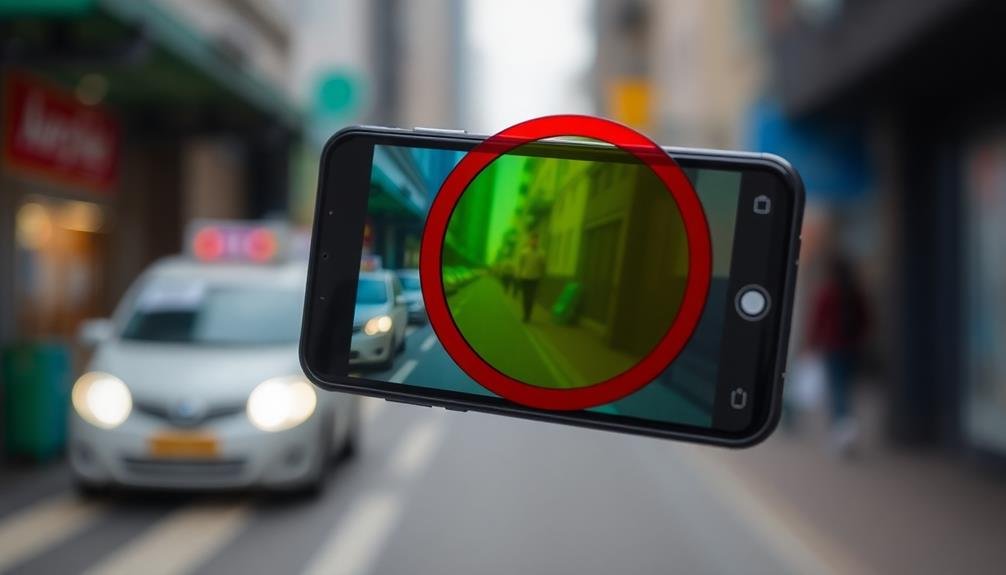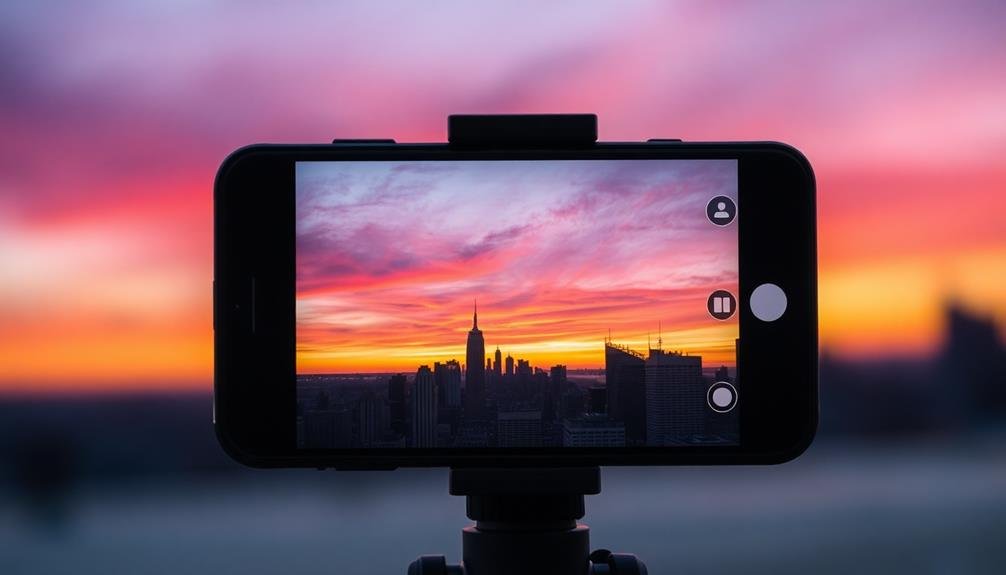Creative lens filters can dramatically enhance your smartphone photos, turning ordinary shots into stunning works of art. You'll find various types, including color filters for mood adjustments, prism filters for ethereal effects, and soft focus filters for dreamy portraits. To get started, choose filters that match your creative vision and guarantee compatibility with your phone model. Proper installation and care are vital for ideal results. You can experiment with combining filters, adjusting strengths, and using editing apps to fine-tune your images. Whether you're aiming for vintage vibes or dramatic contrasts, there's a filter technique to elevate your mobile photography. Discover how these simple accessories can reveal a world of creative possibilities.
Understanding Smartphone Lens Filters

While smartphone cameras have come a long way, lens filters can take your mobile photography to the next level. These attachable accessories transform your phone's camera, enhancing its capabilities and allowing for creative effects.
Smartphone lens filters come in various types, each serving a specific purpose. UV filters protect your lens from scratches and reduce haze, while polarizing filters minimize glare and enhance color saturation. Neutral density (ND) filters reduce light entering the lens, enabling longer exposures or wider apertures in bright conditions. Color filters alter the mood of your images by adding tints or adjusting white balance.
When choosing filters, consider compatibility with your phone model and the quality of materials used. Opt for multi-coated glass filters for better light transmission and durability.
You'll find clip-on, magnetic, and screw-on attachment options, each with its own pros and cons.
To use filters effectively, experiment with different combinations and settings. Start with a basic kit and expand as you grow more comfortable.
Types of Creative Lens Filters

Beyond the basic filters mentioned earlier, there's a world of creative lens filters to explore. These filters can transform your smartphone photos, adding unique effects and enhancing your artistic vision.
Bokeh filters create dreamy, out-of-focus backgrounds, perfect for portraits or close-up shots. They're available in various shapes, like hearts or stars, adding a whimsical touch to your images.
Prism filters split light into rainbow hues, producing ethereal, colorful effects that can make ordinary scenes extraordinary.
For those who love vintage aesthetics, try color filters. These tinted lenses can give your photos a nostalgic feel, mimicking the look of old film stocks.
Soft focus filters subtly blur your images, creating a romantic, dreamy atmosphere ideal for portraits or landscapes.
If you're into abstract photography, consider kaleidoscope filters. They multiply and fragment your subject, resulting in mesmerizing, symmetrical patterns.
Starburst filters add a sparkle to light sources, enhancing street scenes or night photography.
Lastly, don't overlook specialty filters like infrared or ultraviolet. These can reveal hidden details in nature or create surreal, otherworldly images that push the boundaries of your creativity.
Choosing the Right Filter

When selecting a filter for your phone camera, consider the effect you're aiming to achieve.
You'll want to match the filter's capabilities to your creative vision, whether that's softening light, adding color, or creating unique patterns.
Additionally, factor in the filter's material and durability to guarantee it can withstand regular use and potential mishaps during your photography adventures.
Desired Effect Matters
To choose the right filter for your phone photos, consider the desired effect you want to achieve. Different filters can dramatically alter the mood and style of your images, so it's essential to match the filter with your creative vision.
For a vintage look, opt for filters that add a warm, sepia tone or subtle film grain. These work well for nostalgic scenes or portraits with a timeless feel.
If you're aiming for a dramatic, high-contrast effect, look for filters that deepen shadows and enhance highlights. These can transform landscape shots into striking, moody images.
For a fresh, vibrant appearance, select filters that boost saturation and clarity. These are ideal for nature photography or food shots.
If you're going for a dreamy, ethereal vibe, choose filters that soften details and add a subtle glow. These work wonders for romantic portraits or misty landscapes.
Material and Durability
Selecting a high-quality filter for your phone's camera involves considering the material and durability of the lens attachment. Most filters are made from glass or plastic, each with its own advantages. Glass filters typically offer superior optical clarity and scratch resistance, but they're more fragile and expensive.
Plastic filters are lighter, more affordable, and less likely to shatter if dropped, but they can scratch more easily and may not provide the same level of image quality.
When evaluating durability, look for filters with sturdy construction and protective coatings. Multi-coated filters resist scratches, smudges, and glare better than their uncoated counterparts.
If you're frequently shooting outdoors or in challenging conditions, consider filters with weather-sealing features to protect against dust and moisture.
The mounting mechanism is another vital factor. Clip-on filters are versatile and can be easily attached or removed, but make sure they fit securely to avoid slipping during use.
Screw-on filters offer a more stable connection but may require a specific case or adapter for your phone.
Ultimately, choose a filter that balances optical performance with durability to suit your shooting style and environment.
Installing Lens Filters Correctly

When you're ready to install lens filters on your phone, proper alignment is essential for ideal results.
You'll want to carefully position the filter over your camera lens, ensuring it's centered and level.
Be sure to handle the filter by its edges to avoid fingerprints, and give it a quick inspection to remove any dust or debris before attaching it to your device.
Proper Alignment Techniques
In line with improving your smartphone photography, proper alignment of lens filters is essential for achieving ideal results. When attaching a lens filter to your phone, verify it's centered over your device's camera lens. Any misalignment can lead to vignetting or distortion in your images.
Start by cleaning both your phone's lens and the filter to remove any dust or fingerprints. Carefully position the filter over the camera, making sure it's parallel to the phone's surface. Many clip-on filters have alignment markers or grooves to help you position them correctly.
If you're using a case-mounted filter system, double-check that it's securely attached and level. For screw-on filters, gently thread them onto the lens adapter, being careful not to cross-thread or overtighten.
Use the phone's camera app to preview the image and check for any dark corners or blurry areas, which could indicate misalignment. If you notice any issues, make small adjustments until the view is clear and unobstructed.
Avoiding Fingerprints and Debris
Keeping your lens filters clean is vital for capturing crisp, clear photos with your smartphone. Fingerprints and debris can greatly degrade image quality, so it's important to handle and maintain your filters properly.
When installing lens filters, always use a microfiber cloth to grip the edges, avoiding direct contact with the glass surface. Before attaching, gently blow off any dust particles using a blower or compressed air. If you notice smudges or fingerprints, use a lens cleaning solution and a microfiber cloth to clean both sides of the filter carefully.
Store your filters in protective cases when not in use to prevent scratches and accumulation of dust. If you're shooting in dusty or sandy environments, consider using a UV filter as a protective layer for your phone's main lens.
Regularly inspect your filters for any signs of dirt or damage. Clean them before and after each use, and replace filters that show notable wear or scratches.
Mastering Color Filters

Color filters offer a powerful way to transform the mood and aesthetic of your photos. By experimenting with different hues, you can create dramatic effects or subtle enhancements that elevate your images.
Start by familiarizing yourself with the color wheel and understanding complementary colors. This knowledge will help you choose filters that enhance or contrast with your subject.
For warm, nostalgic vibes, try orange or sepia filters. These work well for landscapes and portraits, adding a golden glow to your shots. If you're aiming for a cool, calming atmosphere, opt for blue or teal filters. These are perfect for water scenes or cityscapes.
Green filters can add a fresh, natural feel to outdoor photos, while purple filters create a dreamy, otherworldly effect.
Don't forget about black and white filters, which can lend a timeless quality to your images. Experiment with different intensities and combinations to find your signature style.
Exploring Specialty Effect Filters

Specialty effect filters open up a world of creative possibilities for your phone photography.
These filters go beyond basic color adjustments, allowing you to add unique and eye-catching elements to your images. You'll find a wide range of options, from subtle enhancements to dramatic transformations.
One popular specialty filter is the starburst effect, which adds a twinkle to bright light sources in your photos. It's perfect for capturing sunsets or city lights at night.
Another favorite is the soft focus filter, which creates a dreamy, ethereal look by slightly blurring the image while maintaining sharpness in key areas.
For a more dramatic effect, try a prism filter. It splits light into rainbow-like patterns, adding a surreal touch to your shots.
If you're into vintage aesthetics, look for filters that simulate old camera effects, such as light leaks or film grain.
Don't overlook the fun and quirky options like kaleidoscope or fisheye filters. These can turn ordinary scenes into playful, abstract compositions.
Combining Multiple Filters

You can create unique effects by layering multiple filters on your phone photos.
Experiment with combining different color and texture filters to achieve a distinctive look that sets your images apart.
Remember to adjust the strength of each filter to maintain balance and avoid overwhelming the original photo.
Layering for Unique Effects
Frequently, combining multiple filters can create unique and eye-catching effects that a single filter can't achieve. By layering filters, you'll reveal a world of creative possibilities for your phone photos.
Start by selecting a base filter that enhances the overall mood or tone of your image. Then, experiment with adding complementary filters on top to fine-tune specific elements.
For instance, you might apply a warm, vintage filter as your base, then layer a subtle vignette to draw attention to the center of your image. Or, combine a black and white filter with a color splash effect to highlight a particular subject.
Don't be afraid to adjust the intensity of each filter layer to achieve the perfect balance.
Remember to reflect on the order in which you apply filters, as this can greatly impact the final result. Some apps allow you to rearrange filter layers, giving you even more control over the outcome.
As you experiment with different combinations, you'll develop a signature style that sets your photos apart. Just be careful not to overdo it – sometimes, less is more when it comes to filter layering.
Color and Texture Combinations
Building on the concept of layering filters, exploring color and texture combinations opens up a new domain of creative possibilities. By combining different colored filters with textured ones, you'll create unique effects that can dramatically transform your phone photos.
Start by selecting a color filter that complements your subject or enhances the mood you're aiming for. Then, add a textured filter to introduce depth and visual interest.
For instance, pair a warm orange filter with a subtle grain texture to evoke a vintage feel, or combine a cool blue filter with a soft focus texture for a dreamy atmosphere. Experiment with contrasting colors and textures to create striking visual impact.
Try a vibrant purple filter with a crackle texture for an edgy, urban look, or blend a soft green filter with a light leak effect for an ethereal, nature-inspired image.
Don't be afraid to adjust the intensity of each filter to find the perfect balance. Remember, the key is to enhance your photo without overwhelming it.
As you become more comfortable with these combinations, you'll develop your own signature style that sets your phone photography apart.
Balancing Filter Strengths
The art of combining multiple filters lies in achieving a harmonious balance. When layering filters, you'll need to reflect on how each one affects the overall image.
Start with your primary filter, then gradually add others, adjusting their strengths to complement rather than overpower each other. Remember, subtlety is key – you're aiming to enhance your photo, not mask its original essence.
Pay attention to how filters interact with different elements in your composition. A color filter might enhance the sky but affect skin tones, while a texture overlay could add depth to landscapes but distract from portraits.
Experiment with opacity levels to fine-tune the impact of each filter.
To master the art of balancing filter strengths, focus on these emotional goals:
- Intrigue: Create depth and mystery by layering subtle filters.
- Impact: Use bold combinations sparingly to make key elements pop.
- Harmony: Blend filters seamlessly to evoke a cohesive mood.
Editing Photos With Filters

With a few taps, you can transform your ordinary photos into stunning works of art using filters. Most photo editing apps offer a wide range of preset filters that can instantly change the mood and style of your images. Experiment with different options to find the ones that best suit your aesthetic preferences and the subject matter of your photos.
When editing with filters, consider the following aspects:
| Filter Type | Effect |
|---|---|
| Vintage | Adds a nostalgic, retro look |
| Black and White | Creates dramatic, timeless images |
| High Contrast | Enhances details and color intensity |
| Warm Tones | Adds a cozy, golden hue |
| Cool Tones | Produces a calm, bluish atmosphere |
Remember that filters are just a starting point. After applying a filter, fine-tune your image by adjusting brightness, contrast, saturation, and other settings. Don't be afraid to mix and match filters or create your own custom presets. As you become more comfortable with editing, you'll develop your unique style and learn which filters work best for different types of photos and lighting conditions.
Caring for Your Lens Filters

Once you've invested in quality lens filters, proper care is essential to maintain their performance and longevity.
Always handle filters by their edges to avoid fingerprints and smudges on the glass surface. When not in use, store your filters in protective cases or pouches to shield them from dust and scratches.
Regularly clean your filters using a microfiber cloth or lens cleaning solution, gently wiping in a circular motion from the center outward.
Be cautious when attaching or removing filters from your phone's lens. Avoid over-tightening, as this can damage both the filter and your device.
When traveling, pack your filters securely in a padded case to prevent accidental drops or impacts.
To guarantee you're getting the most out of your lens filters, follow these emotional cues:
- Feel the excitement of capturing stunning images with pristine filters
- Experience the satisfaction of preserving your investment through proper care
- Embrace the confidence that comes from knowing your filters are always ready for action
Budget-Friendly Filter Options

Photography enthusiasts on a tight budget need not despair when it comes to lens filters for their smartphones. There are plenty of affordable options that can help you enhance your mobile photography without breaking the bank.
Start by exploring DIY solutions, such as using household items like colored cellophane or plastic wrap to create unique effects. You can also repurpose old sunglasses or 3D glasses lenses for interesting color shifts.
For those who prefer ready-made options, many online marketplaces offer inexpensive clip-on lens filter sets for smartphones. These typically include basic filters like UV, polarizer, and neutral density. While they may not match the quality of high-end filters, they're an excellent starting point for experimenting with different effects.
Another budget-friendly approach is to look for second-hand filters from camera shops or online marketplaces. You can often find quality filters at a fraction of their original price.
Don't forget to check out smartphone apps that simulate filter effects digitally. While not physical filters, they can provide similar results without any additional hardware.
Frequently Asked Questions
Can Lens Filters Affect the Quality of Night Mode Photos?
Yes, lens filters can impact your night mode photos. They might reduce light transmission, affecting exposure and clarity. However, some filters like ND or color-correcting filters can enhance night scenes when used correctly. Experiment to find what works best.
Are There Lens Filters Specifically Designed for Selfie Cameras?
Yes, there are lens filters designed for selfie cameras. You'll find clip-on options that fit over your phone's front camera. They can enhance your selfies with effects like soft focus, color tints, or even star-shaped light flares.
How Do Lens Filters Impact Smartphone Battery Life?
Lens filters typically don't impact your smartphone's battery life. They're passive accessories that don't require power. However, if you're using an app to apply digital filters, it may drain your battery faster due to increased processing.
Can Lens Filters Be Used With Protective Phone Cases?
You'll be glad to know that many lens filters can be used with protective phone cases. They're often designed to clip on or attach magnetically over your case. However, some cases might interfere with filter placement, so check compatibility first.
Are There Any Risks of Damaging the Phone's Camera When Using Filters?
You're unlikely to damage your phone's camera when using filters properly. However, if you're not careful, you could scratch the lens or leave residue. Always follow instructions and use high-quality filters to minimize risks.
In Summary
You've now got the tools to transform your smartphone photos with creative lens filters. Don't be afraid to experiment with different types and combinations. Remember to install them correctly and care for them properly. Whether you're using physical filters or editing apps, you'll reveal new possibilities for your photography. Keep practicing, and you'll soon master the art of enhancing your phone photos with these versatile accessories. Happy shooting!





Leave a Reply